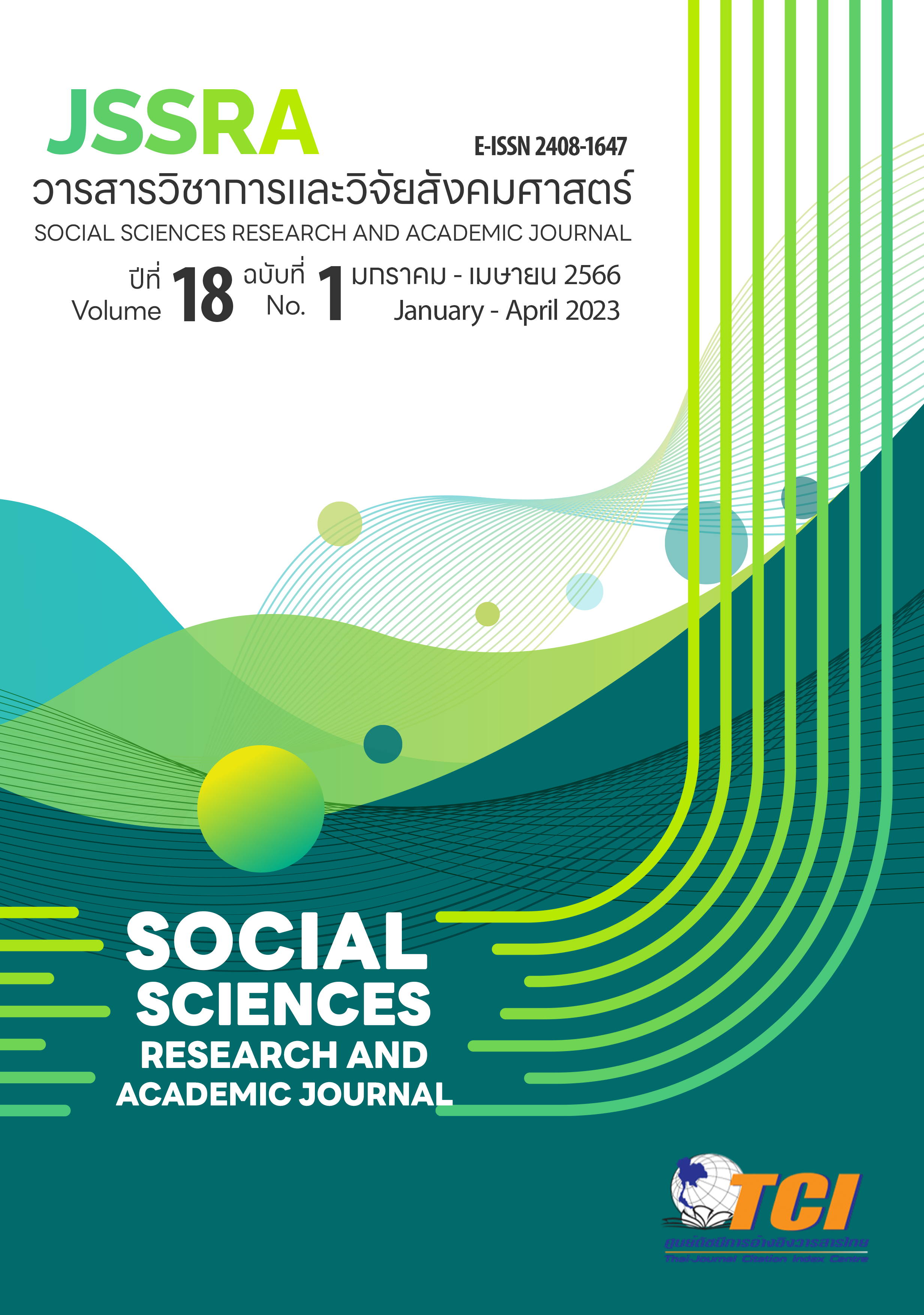Potential Development for Sustainable Community- Based Tourism Management of Thammamoon Sub-district, Mung District, Chinat Province Potential Development for Sustainable Community- Based Tourism Management of Thammamoon Sub-district, Mung District, Chinat Province
Main Article Content
Abstract
The objectives of this research were: 1) to study the need for potential development for sustainable community-based tourism management and 2) to develop the guidelines promote for sustainable community-based tourism management. This research is a Mixed Method Research. Population and sampling in this area and key informant use questionnaires, interview forms and focus group. Data were analyzed with descriptive and content statistics.
The findings of this research as following:
1) The need for potential development for sustainable community-based tourism management in this area of landscape and ecosystem improve to realize the value and cherish the culture and local traditions, knowledgeable resources management, build the prosperity and reputation of the community, generate and distribute income, collaborate to conserve the environment and resources, create a tourism market, public relations, tourist attraction development, career promotion and employment, raise the level of development of groups, organizations and networks, lifestyles and unique cultures, planning and decision between tourists and community learners, knowledge development for information and communication skills, development tourism routes and itineraries etc. Participation to sustainable community-based tourism development requires government, local and community in organizing tourism activities with their occupations and cultural lifestyles, improvement utilities to access tourist attractions and have signs pointing to tourist attractions. Organizations and communities participate in the conservation of tourism resources. Government and local government training to development restoration and conservation of resources, improvement of landscape, disposal of waste, sewage and waste water offer opinions on the development of tourism activities, development in accommodation to be safe, making a map of the journey to the attraction, planning community tourism development, arrange a place and facilities to tourists as well as improving information systems and disseminating public relations.
2) The guidelines for promoting and developing sustainable community-based tourism management focus on (1) the potential of community-based tourism in this area is history, culture, temples, old Buddha images, the place that King Rama V and King Rama IX came to pay their respects, farming methods near the province, viewpoint on the top of the mountain, learning resources, local market, development and upgrading with knowledge, skills and development of places and facilities.
(2) The creating community-based tourism activities is unique community, history, culture, and the Chao Phraya River and public ponds, agricultural learning center, fruit orchards and local market. (3) The community lifestyle change problems and impacts of community-based tourism management about understanding the purpose goals to community-based tourism, training, skill development, community preparation, recognizing, appreciating and cherishing the way of life of the community, cultural way of life and participation resources management. (4) The participation in the promotion and development of tourist attractions, government and local government support, promote, develop coordination, support budgets and organize projects and activities the area development and learning resources. (5) The Guidelines for promoting and developing sustainable community-based tourism management is the creating value, realizing and learning the social capital and cultural ways for the strength of the community, accessing value and creating value in livelihoods and local wisdom, the facilitation and opening up space for people inside and outside, public relations, build safety, creating network and develop the environment and the participation to community-based tourism management ecosystem.
Article Details
References
การท่องเที่ยวแห่งประเทศไทย, (2563). แผนพัฒนาการท่องเที่ยวแห่งชาติ ในปี 2560-2564. สืบค้นเมื่อวันที่ 8 กรกฎาคม 2563 (ระบบออนไลน์) จาก http://www.tourism.go.th
กระทรวงการท่องเที่ยวและกีฬา. (2563). ข้อมูลเชิงวิชาการการท่องเที่ยว. สืบค้นเมื่อ วันที่ 8 กรกฎาคม 2563 (ระบบออนไลน์) จากhttp://www.webhost.mots.go.th/tour_descriptian.htm
กฤติยา จักรสาร. (2545). การส่งเสริมความรู้พื้นฐานด้านพฤษศษสตร์ให้แก่มัคคุเทศก์และนักท่องเที่ยวเพื่อเพิ่มคุณค่าทางการท่องเที่ยว. วิทยานิพนธ์ปริญญามหาบัณฑิต มหาวิทยาลัยเชียงใหม่, เชียงใหม่.
ธัญณ์ณภัทร์ เจริญพานิช, สุขสมาน สังโยคะ และอรชร ฉิมจารย์. (2564). การยกระดับศักยภาพการท่องเที่ยวชุมชนแบบสร้างสรรค์ของตำบลนครชุม จังหวัดพิษณุโลก. วารสารวิจัยเพื่อการพัฒนาเชิงพื้นที่, 13(5), 372-387.
เบญญาภา เศรษฐทัตต์. (2553). ศึกษาทุนทางสังคมกับการจัดการท่องเที่ยวเชิงอนุรักษ์ กรณีศึกษาตลาดคลองสวนร้อยปี อำเภอบางบ่อ จังหวัดสมุทรปราการ. วิทยานิพนธ์ ศิลปศาสตรมหาบัณฑิต การบริหารการพัฒนาสังคม สถาบันบัณฑิตพัฒนบริหารศาสตร์, กรุงเทพฯ.
พัชรินทร์ จึงประวัติ. (2560). ความต้องการของชุมชในการพัฒนาศักยภาพเพื่อการจัดการท่องเที่ยวเชิงอนุรักษ์: กรณีศึกษาตลาดคลองสวนร้อยปี อำเภอบางบ่อ จังหวัดสมุทรปราการ. วารสารการบริการและการท่องเที่ยวไทย, 12(1), 42-43.
วัฒนาพร อิมสุรรณ์ และคณะ. (2553). แนวทางการพัฒนาทุนชุมชน. สำนักพัฒนาทุนและองค์กรการเงินชุมชน กรมการพัฒนาชุมชน. กรุงเทพฯ.
วัฒน์จิรชัย เวชชนินนาท. (2559). การเสริมสร้างศักยภาพทางการตลาดของแหล่งท่องเที่ยวชุมชนบ้านนาดี-สร้างบง ตำบลผาสุก อำเภอกุมภวาปี จังหวัดอุดรธานี. วารสารวิจัยเพื่อการพัฒนาเชิงพื้นที่, 8(3), 37.
วิมลมาลย์ สวัสดี. (2563). การพัฒนาศักยภาพของวิสาหกิจเพื่อสังคมด้านการท่องเที่ยวในประเทศไทย. วารสารพัฒนาสังคม, 22(2), 1-22.
สินธุ์ สโรบล. (2546). แนวคิดการจัดการท่องเที่ยวโดยชุมชน. กรุงเทพฯ: สำนักงานกองทุนสนับสนุนการวิจัย.
สำนักงานคณะกรรมการพัฒนาการเศรษฐกิจและสังคมแห่งชาติ. “แผนพัฒนาเศรษฐกิจและสังคมแห่งชาติ ฉบับที่ 12(พ.ศ.2560-2564). สืบค้นเมื่อวันที่ 8 กรกฎาคม 2563 (ระบบออนไลน์) จาก http://www.nesdb.go.th/Portals/0/news/plan/p11/plan12.
สำนักงานจังหวัดชัยนาท. (2563). แผนพัฒนาจังหวัดชัยนาท (พ.ศ.2561-2564). (ม.ป.ป.).
สำนักทะเบียนราษฎร์อำเภอเมืองชัยนาท. ประชากรตำบลธรรมามูล จังหวัดชัยนาท, (ม.ป.ป.).
สำนักงานพัฒนาชุมชนอำเภอเมืองชัยนาท. (2560). คู่มือนักท่องเที่ยว TRAVEL ธรรมามูล. สำนักพิมพ์สตางค์มีเดีย.
องค์การบริหารการพัฒนาพื้นที่พิเศษเพื่อการท่องเที่ยวอย่างยั่งยืน. (2559). แผนยุทธศาสตร์การท่องเที่ยวโดยชุมชนอย่างยั่งยืน พ.ศ. 2559-2563. สืบค้นเมื่อวันที่ 7 กรกฎาคม 2563 (ระบบออนไลน์) จาก http://www.dasta.or.th/th/aboutus/item/3343.
Richards, G. (2010). Creative Tourism and Local Development. In Wurzburger, R. (Ed.). Creative Tourism A Global Conversation how to provide unique creative experiences for travelers worldwide: at present at the 2008 Santa Fe & UNESCO International Conference on Creative Tourism in Santa Fe. (pp. 78–90). New Mexico. USA.
Maxwell, J.E. (1988). The vegetation of Doi Suthep-Pui Nation Park, Chiangmai Provice, Thailand. Tigerpaper (FAO), 15(4), 6-14.


